If I was in this range, for sure!
The rest of the suggestions are spot-on as well, obviously.
Great review for those looking in this strata!
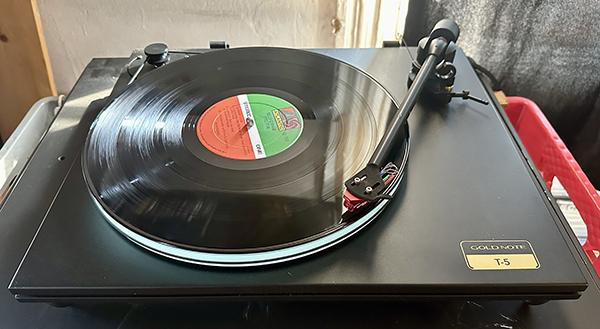
For quite some time now, I’ve strongly felt the audio industry is long overdue for a true mid-fi revolution, the kind that kickstarted our respective listening lifestyles back in the days of early transistor radios, bulky turntables, and primitive tube amps. Verily, I say we need a mid-fi renaissance! Bring back that raw energy, and that connection to what we’re spinning. Let’s ditch the chrome and get back to what matters most — the music.
Some further background first, if you will. I live not that far from the old Long Island City buildings in Queens, New York, where Fisher amps and Fairchild cartridges were manufactured. Back in the day, Henry Kloss’ famous KLH speakers and Acoustic Research amplifiers helped jumpstart the love of all things high-end audio, as did AR Research with their AR-XA turntables. Kloss was back in the game with his exceedingly popular The Advent Loudspeaker in the mid-1960s. Saul Marantz had launched his legendary brand, manufacturing integrated amplifiers, tuners, and receivers around the same time as the Russian Sputnik made interstellar outer-space waves, in turn inspiring the U.S. aerospace industry.
These brands were not necessarily aimed at the well-heeled consumer looking to impress (though that was certainly one element of the equation). We’re talkin’ shade-tree mechanics taking a crack at fixing their own radios, and ham-radio enthusiasts building their own rigs to chat with folks across the country. Heck, half the mid-century modern living rooms sported giant consoles. You want that perfect AM station? You spent hours fiddling with knobs, chasing that sweet spot on the dial.

These weren’t luxury items, mind you, but a prosperous everyman’s gateway to good sound. They cranked out music with an immediacy that today’s digital gizmos can’t touch (even if, of course, they didn’t exactly measure all that well). Cranking your favorite record, the whole house would be vibrating with the sound. That’s what mid-fi was all about.
Now, it is true that everyman audio still exists today, but potential gear owners may feel cowed by the high prices demanded of superior components. But then, as if right on cue, the Gold Note T-5 turntable — which sports the truly reasonable SRP of $1,000, with tonearm — comes to the rescue.
As some might see it, the T-5 isn’t cheap — but it’s my belief that, if you’re serious about your music, $1K is a reasonable fee for this level of build quality, smart design, and rock-solid performance this table offers, one that happens to share trickle-down tech from Gold Note’s excellent Mediterraneo X table.
But before I get into the meat of my T-5 review, I wanted to first get a better, firsthand look at how Gold Note makes their gear, and I was lucky enough to have the opportunity to go right to the source in Italy, just a few short months ago.
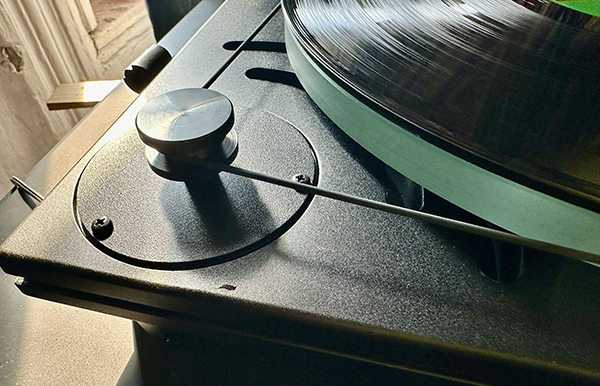
Site Visit in Italia
So, picture this. Firenze. Italy. Springtime. Sun-dappled olive groves that stretch on forever. Postcard-perfect green rolling hills dotted with terracotta-roofed farmhouses. Breathtaking, to be sure — but I wasn’t there for the tourist traps. Nope, this trip was about a pilgrimage to the modern audio temple that is Gold Note. Between feasting on plates piled high with fresh pasta and glasses spilling Chianti, I found Gold Note to be all about fine Italian audio.
Gold Note’s showroom/factory is a single building dedicated to sonic wonder. Watching their craftsmen and women work on the factory floor, I saw their movements to be precise and well-tuned. The hum of CNC machines and cutting machinery was counterpoint to the melodies spilling from the speakers (and boomboxes). Dressed in company t-shirts, Gold Tech techs wired amps in one area, assembled speakers and turntables in another, and boxed cartridges in yet another space distinct from the main factory floor.
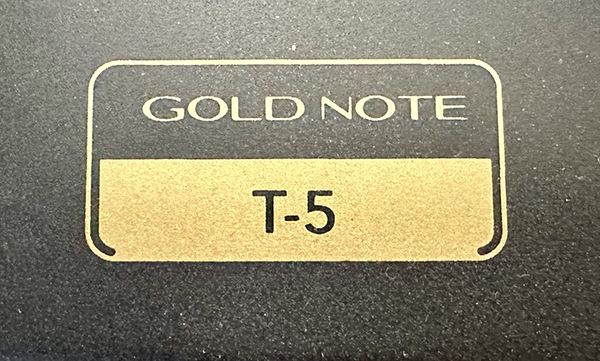
The entrance to the Gold Note facility literally opens into an art gallery, where dozens of paintings by local artists were posted on walls surrounding a large swimming pool. Dedicated listening rooms were also open, one housing Gold Note’s new The Diana speakers, their statement Bellagio Conquest turntable, PH-1000 phono preamp, P-1000 MKII preamp, PA-1175 MKII power amp, and XS-85 loudspeakers. A smaller room held prototype and mid-fi gear. Needless to say, the sound I experienced while I was there was fantastic.
I could have stayed at the Gold Note facility in Firenze, well, forever, but I did have to get back across the Pond to attend to my impending, never-ending stateside duties — including the T-5 table review you’re reading right now. Let’s get back to it.
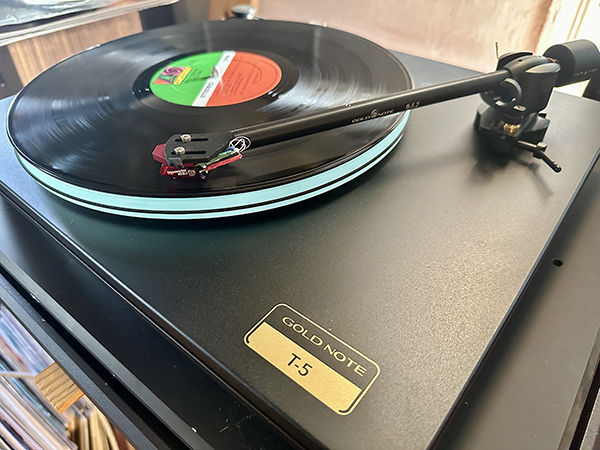
Features & Specs
Made entirely by hand in Italy, the Gold Note T-5 employs a 15mm thick platter made of clear glass, which “provides the right density and structure to extract fine details from the groove while minimizing noise,” according to the company’s site. “The platter is matched with an inverted bearing, an elegant solution to increase the stability of the platter while also ensuring frictionless rotation.”
The T-5’s black lacquered plinth is 23mm thick and made of HDF (high-density fiberboard). Continues that site posting, “The plinth is further refined by removing material in strategic points (around the motor, the bearing and the edges) to create a shape that minimizes resonance by breaking the transmission pattern of vibrations.”
To get further clarification, I went directly to Gold Note. “The plinth is a lacquered HDF, an inert undeformable material, shaped and cut in strategic areas around the motor and the platter spindle to avoid the propagation of vibrations,” wrote Gold Note founder and CEO Maurizio Aterini, via email. “The belt is made of 70 shore elasticity EPDM. That is a rubber material particularly beneficial for turntable belts because it doesn’t contain too much elastic, which is unable to absorb vibration, or silicone, which is too fragile to guarantee a long working life.”
Continued Aterini, “The T-5’s motor is a 12V, 24-stepped synchronous motor customized for Gold Note by Mechtex. The counterweight is made of black painted brass, while the headshell is precisely made with our 3D printers of a hardened, synthesized photo-polymer, which guarantees strong rigidity and ideal vibration control.”
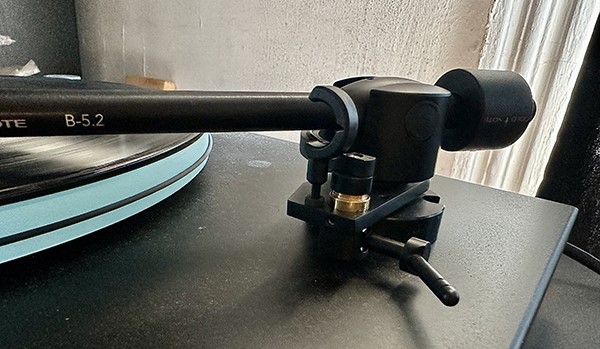
The belt-drive T-5 table includes Gold Note’s own B-5.2 9in tonearm. The B-5.2 arm builds on the strengths of the previous B-5.1 iteration. The B-5.2 is a static balance arm employing four custom-made micro ball-bearings, a 1mm thick aluminum 6000 alloy arm wand, and AWG36 Hyper Litz, shielded, 99.9999% OFC continuous copper wiring from the headshell to the connecting RCAs cable — a very rare choice for a turntable in this price range. VTA is adjustable via a grubscrew on the assembly shaft. Azimuth is also adjustable via two grubscrews set at the junction of the tonearm and headshell. Anti-skating is the familiar nylon filament and aluminum ball arrangement. The bulk of the tonearm assembly is aluminum as well.
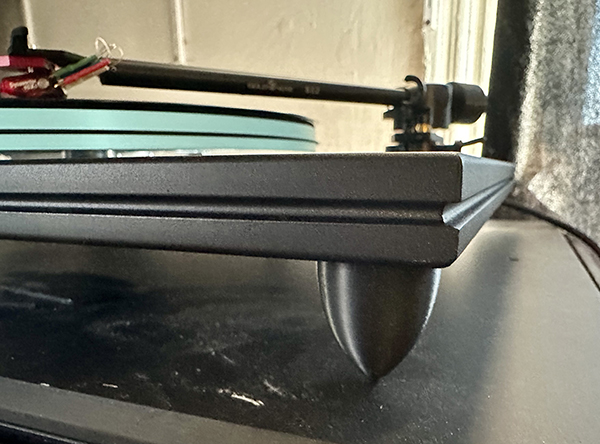
The T-5 included four very large feet, the largest I’ve seen on a table in this price range. “The T-5 feet are made of NBR,” clarified Aterini, “a rubber polymer, and features a 6mm threaded steel rod as an insert inside to adjust the height. The NBR, helped by the footer’s special phaser shape design, is able to absorb vibrations and grant elasticity. The T-5 is the only semi-floating model turntable in our catalogue.”‘
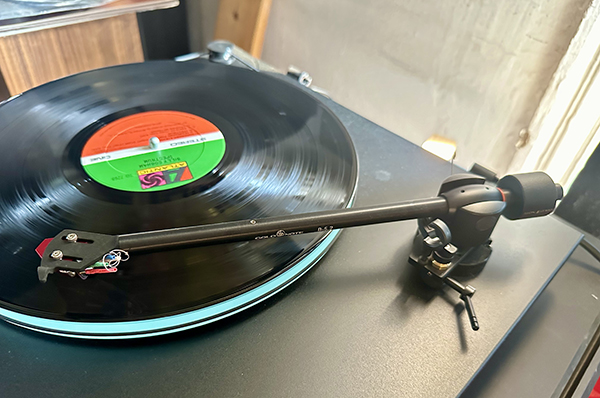
Setup
My rig for this T-5 table review included the Luxman LMC-5 moving coil (MC) cartridge, PrimaLuna EVO 100 phono preamp, Rogue Audio RP-7 preamp, Air Tight ATM-1 2024 Edition power amp, and GoldenEar BRX loudspeakers. Cabling consisted of various runs of AudioQuest and Triode Wire Lab wire. After mounting the Luxman LMC-5 MC cart on the Gold Note B-5.2 arm, I got down to the listening business.
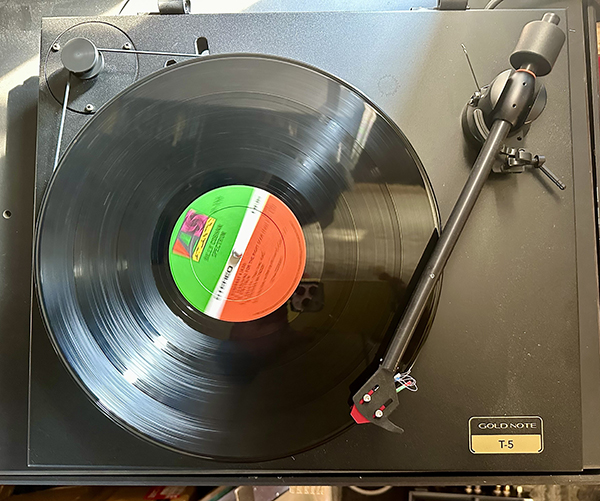
Listening Sessions
I freely acknowledge that pairing a $1K turntable with a system that runs into the thousands of dollars may be odd. That said, the Gold Note T-5 played with engaging synergy in this system, proving its mettle as a table that not only plays well with similarly priced gear — including a PrimaLuna integrated amp and Tavish Audio Design phono preamp — but holds its own amid top-tier components.
The T-5’s four large spherical feet did their job well. Isolation was key. Out of the gate, the T-5 played with supreme engagement, good tone and detail retrieval, and the kind of fast communication and swift release of notes I associate with the PRaT (Pace, Rhythm, and Timing) school of turntable design.
I played a variety of LPs to appraise the T-5, including Bill Evans’ Intuition (Fantasy F4975), Wes Montgomery’s Down Here on the Ground (A&M SP-3006), Kenny Clare and Ronnie Stephenson’s Drum Spectacular (Music for Pleasure SPR-90057), Jerome Sabbagh’s Heart (Analog Tone Factory [catalog number not apparent]), and Billy Cobham’s Spectrum (Atlantic SD 7268).
Evans’ July 1975 release Intuition, as performed with bassist Eddie Gomez, is a rare duo album in the master jazz pianist’s discography. A mid-’70s recording, it does suffer from a certain darkness in sound, like someone forgot to add sugar. But that also contributed to the production’s lushness, reflected in Gomez’s deep bass tones and the lower range of Evans’ piano. Though the bass and piano were engaging and intimate, there was a lack of resolution and detail though the spread and wide soundstage of the piano were engaging.
Things fared better with jazz-guitar maestro Wes Montgomery’s excellent April 1968 effort Down Here on the Ground. Accompanied by strings, brass, woodwinds and a jazz quartet, Montgomery is in fantastic form. The T-5 brought all the richness of tone, fatness and physicality of the guitar’s body, and the creaminess of the brass to a degree I didn’t think possible with a $1,000 turntable. Granted, the overachieving Luxman MC cart enabled the table to shine, but that trait worked in reverse as well. A giant stage, deep-toned acoustic bass, drums that popped and kicked, and Wes’ brilliant guitar tone and warmth shone through. The T-5 was fast as the dickens, releasing notes as well as any table I’ve heard. It gave Down Here some serious flesh and blood, juice and fire, and heart and soul.
While the T-5 didn’t offer the last word in detail retrieval, resolution, or absolute bass definition, it did present an ultra-large scale, wide-span soundstage, though lacking in absolute depth. You could say the table spotlit some instruments, where a more expensive table — such as my 35-times-more-expensive VPI Avenger Direct — presents larger, more detailed, more whole images. But at $1,000, the T-5 is a monster machine in its own right.
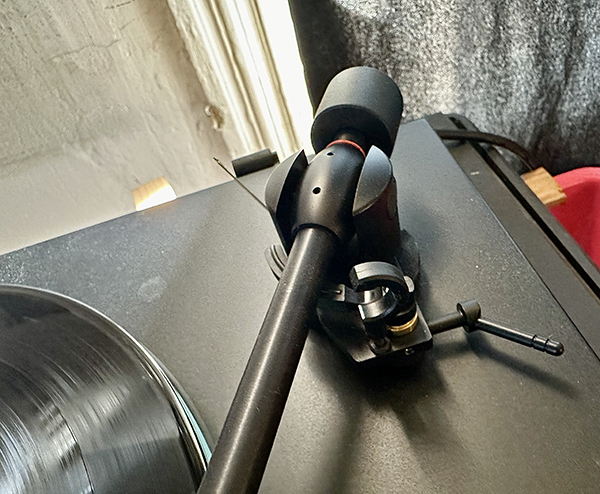
Along with its intelligent design, seen in its ridged plinth and large spherical feet, which both help to break up standing waves and isolate the machine from vibrations, the T-5’s tonearm was equally munificent, tracking smoothly to support soundstage and image stability.
Stability was needed to track Kenny Clare and Ronnie Stephenson’s 1966 LP Drum Spectacular. Featuring two of England’s greatest big-band drummers in the Buddy Rich school, this record is an earthquake of dynamics, a torture test of thunderous lows and sky-shredding treble, and the kind of punch and precision that even more expensive tables fail to capture. I was surprised the T-5 didn’t flinch, producing a thunderous knock-down, drag-out riot of brain and belly-savaging drums and screaming brass. A record of spills and thrills, Drum Spectacular put the T-5 through its paces, the table delivering a sweaty, white-knuckle performance like a racehorse hitting its stride.
The T-5 sounded intimate and warm reproducing tenor saxophonist Jerome Sabbagh’s new 2024 release Heart, but, like the Evans record, it didn’t capture the last iota of detail from this all-acoustic recording. Staging was fine, if images stayed glued to the speakers. The T-5 seemed to excel at large-scale productions, producing levels of gusto and grunt that can elude low-weight tables that favor PRaT over deep bass.
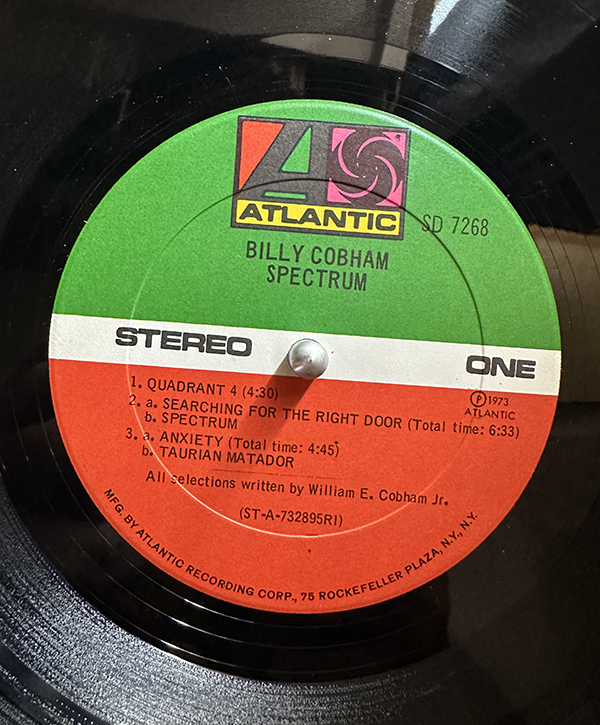
But then the T-5 handled both intimacy and bombast on drummer Billy Cobham’s iconic October 1973 jazz-rock debut, Spectrum. Spinning between thoughtful, Max Roach-inspired solo drum moments (“Stratus”), to hardcore blowout fire breathers with keyboardist Jan Hammer and guitarist Tommy Bolin (“Taurian Matador”), the Gold Note T-5 delivered this frenetic fusion masterpiece with energy to spare. Solo drumming was large if not especially well resolved, while the T-5 relayed the record’s incendiary solos with quaking empathy. The T-5 played my Spectrum LP as well as I’ve heard it, engaging me to air guitar and air drum my way to jazz-rock heaven.
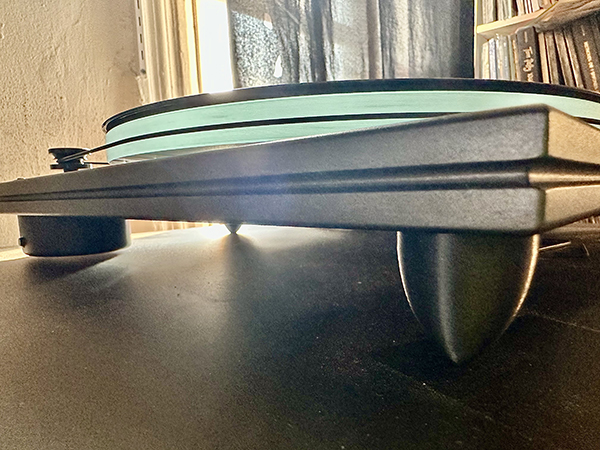
Conclusions
The Gold Note T-5 turntable is an unusual machine. It offered a kaleidoscope of sonic virtues that would captivate any audiophile. It spun with the energetic zest of a PRaT turntable, infusing every note with liveliness and life. But unlike its sprightly counterparts, the T-5 possessed a hidden depth. Its soundstage stretched out like a cruise ship, vast and plentiful. Bass tones rumbled with the lowdown power of a heavyweight player, adding a rich, inky counterpoint to the melody’s bright flourishes.
In the T-5’s price range, Pro-Ject offers the Debut PRO for $999 including tonearm and Sumiko Rainier cartridge. Rega’s Planar 3, with its time-tested RB330 tonearm, comes in at $1,125. Then there’s the E.A.T. Prelude for $999, and the Music Hall MMF-5.3 SE at $1,200.
While those companies are likely better known in the U.S. market, the aural facts here are quite clear — sonically speaking, Gold Note, and more specifically, their T-5 turntable, takes a back seat to no one. You can now officially add the Gold Note T-5 to the list of great belt-drive turntables in the $1,000 range that performs well beyond its price point of entry.
For more about Gold Note, go here.
To find an authorized Gold Note dealer, go here, and click on the Authorized Dealer Section header (which is third from the left).
Author bio: Former musician, former artist, and former legal wastrel Ken Micallef has written numerous hi-fi equipment reviews for Stereophile and Analog Planet, and his byline has also appeared within Mojo, Electronic Musician, and The Grammys. You can also find him at YouTube (Ken Micallef Jazz Vinyl Audiophile).


If I was in this range, for sure!
The rest of the suggestions are spot-on as well, obviously.
Great review for those looking in this strata!

Custom bank statements can contribute to sustainability goals. By generating digital, customizable reports instead of printing large volumes of generic statements as Custom Bank Statements , individuals and organizations can reduce paper usage. Furthermore, digital statements can be stored and accessed easily in the cloud, eliminating the need for physical storage and ensuring the data remains secure and organized.

Hi, Nice review (The only one on the www I could find).
But way did you not install the anti skate system for the review? Seems a bit strange...
Kind regards,
Vince.

The T-5, in contrast to its lively predecessors, had a secret depth. It had a huge, expansive soundstage that resembled a cruise ship. The melody's dazzling Geometry Dash Lite flourishes were counterbalanced by rich, inky bass tones that rumbled with the bluesy force of a heavyweight performer.